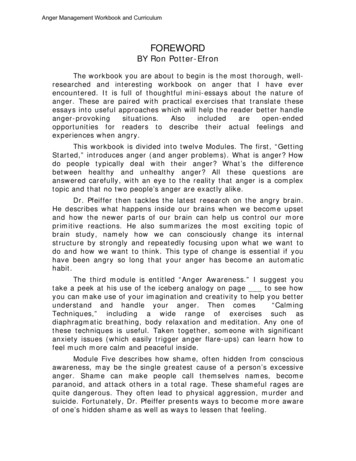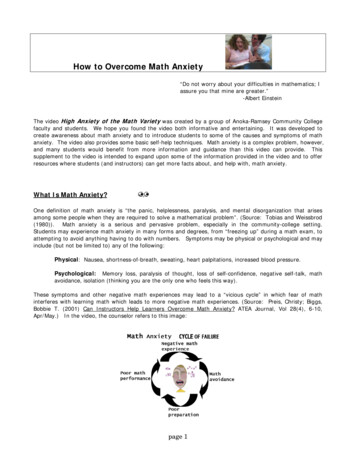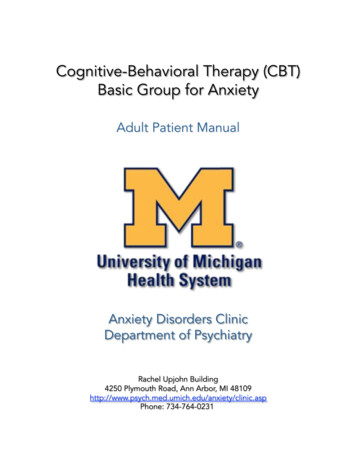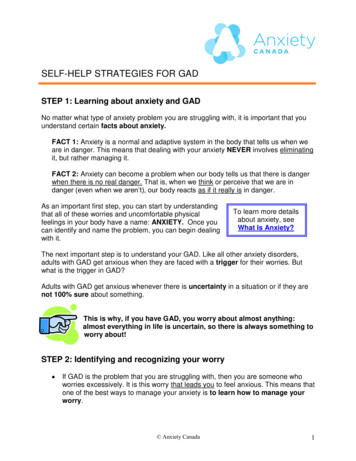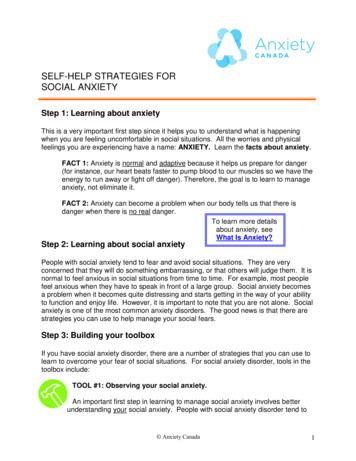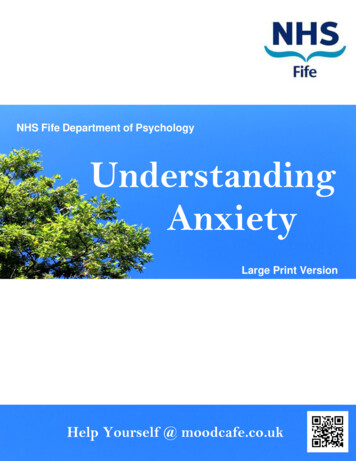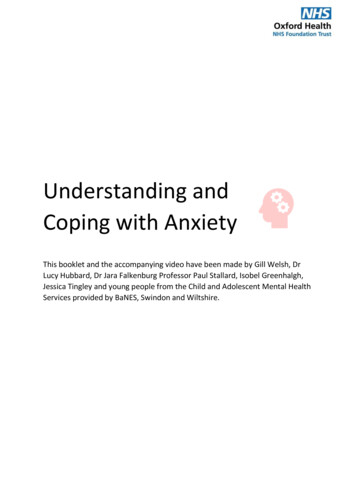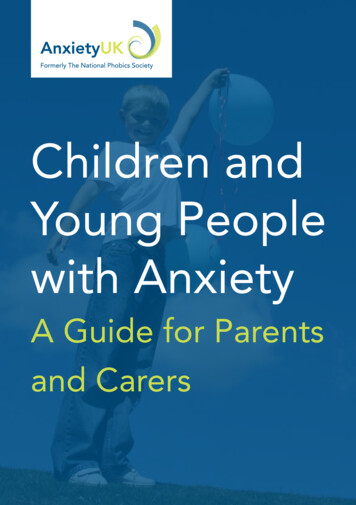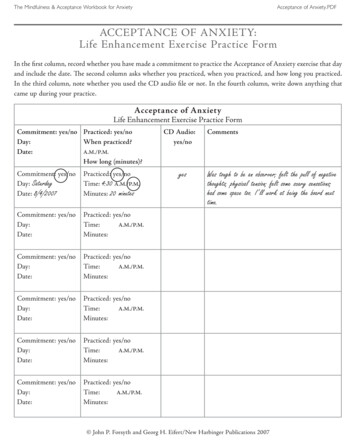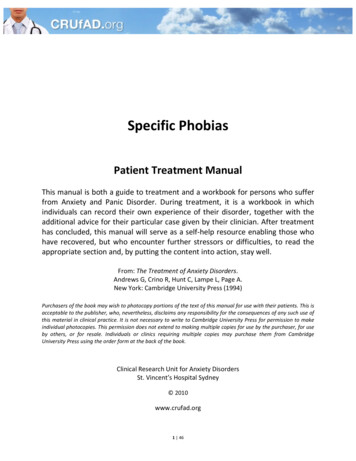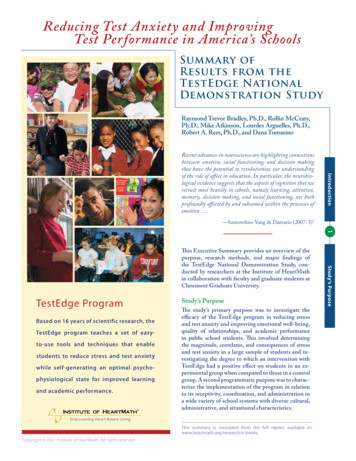
Transcription
Reducing Test Anxiety and ImprovingTest Performance in America’s SchoolsSummary ofResults from theTestEdge NationalDemonstration StudyRaymond Trevor Bradley, Ph.D., Rollin McCraty,Ph.D., Mike Atkinson, Lourdes Arguelles, Ph.D.,Robert A. Rees, Ph.D., and Dana TomasinoIntroductionRecent advances in neuroscience are highlighting connectionsbetween emotion, social functioning, and decision makingthat have the potential to revolutionize our understandingof the role of affect in education. In particular, the neurobiological evidence suggests that the aspects of cognition that werecruit most heavily in schools, namely learning, attention,memory, decision making, and social functioning, are bothprofoundly affected by and subsumed within the processes ofemotion .—Immordino-Yang & Damasio (2007: 3)1 Study’s PurposeTestEdge ProgramBased on 16 years of scientific research, theTestEdge program teaches a set of easyto-use tools and techniques that enablestudents to reduce stress and test anxietywhile self-generating an optimal psychophysiological state for improved learningand academic performance.INSTITUTE OF HEARTMATH The study’s primary purpose was to investigate theefficacy of the TestEdge program in reducing stressand test anxiety and improving emotional well-being,quality of relationships, and academic performancein public school students. This involved determiningthe magnitude, correlates, and consequences of stressand test anxiety in a large sample of students and investigating the degree to which an intervention withTestEdge had a positive effect on students in an experimental group when compared to those in a controlgroup. A second programmatic purpose was to characterize the implementation of the program in relationto its receptivity, coordination, and administration ina wide variety of school systems with diverse cultural,administrative, and situational characteristics.Empowering Heart-Based LivingThis summary is excerpted from the full report, available at:www.heartmath.org/research/e-books.Copyright 2007 Institute of HeartMath. All rights reserved.Study’sPurposePurposeStudy’sThis Executive Summary provides an overview of thepurpose, research methods, and major findings ofthe TestEdge National Demonstration Study, conducted by researchers at the Institute of HeartMathin collaboration with faculty and graduate students atClaremont Graduate University.
Reducing Test Anxiety and ImprovingTest Performance in America’s SchoolsTestEdge ProgramTestEdge ProgramFor the purposes of this study, both teachers and studentsreceived instruction in HeartMath tools and techniquesthrough the Resilient Educator and TestEdge programs,respectively. Used as the intervention in this study, theseprograms were developed by the Institute of HeartMathto help students and teachers reduce stress and test anxiety, improve test and academic performance, and enhanceemotional and relational competence. The programs arebased on 15 years of scientific research on the psychophysiology of learning and performance, emotional dynamics,and heart–brain communication. The programs teacha set of easy-to-use positive emotion refocusing and restructuring techniques that enable teachers and studentsto self-regulate stress, test anxiety, and other emotionalimpediments to learning and performance.The basis of the effectiveness of the techniques is that theyenable the individual to self-activate a specific, scientificallymeasurable state of optimal function, termed psychophysiological coherence. Research has shown that psychophysiological coherence is characterized by increased synchronization in nervous system activity, increased emotionalstability, and improved cognitive and task performance. Research Sites & ParticipantsThe TestEdge program has been successfully implementedin schools throughout the U.S. and in some foreign countries; pilot studies have shown associated improvements instudent standardized test scores, passing rates, and psychosocial functioning. This study marks the first time thatthe efficacy of the TestEdge program has been evaluated ina large-scale implementation.Study’s HypothesesThe study tested two major hypotheses. The first is thatenhanced competence in emotional management throughlearning and practicing the TestEdge tools would result insignificant improvements in student emotional self-regulation and psychophysiological coherence. These changeswould produce a marked reduction in test anxiety, which,in turn, would generate a corresponding improvement inacademic and test performance. Secondly, as a result of theimprovement in student emotion regulation skills, it wasalso expected that there would be associated improvementsin stress management, emotional stability, relationships,and overall student well-being, as well as in classroomclimate, organization, and function.Research Design and MethodsTo investigate the veracity of these hypotheses, two studies were conducted, each with different research objectivesand designs. The first, the primary study, focused on an indepth investigation of students at the tenth grade level. ItCopyright 2007 Institute of HeartMath. All rights reserved.was designed as a quasi-experimental, longitudinal fieldstudy, involving pre- and post-intervention panels ofmeasurement within a multi-methods framework.For the primary study, extensive quantitative and qualitative data were gathered using survey questionnaires, interviews, and structured observation, and an assessmentof student drawings, along with student test scores fromtwo California standardized tests—the California HighSchool Exit Examination (CAHSEE) and the CaliforniaStandards Test (CST). In addition, an electrophysiological sub-study was conducted on a randomly stratifiedsample of students from both schools. Utilizing measuresof heart rate variability (beat-to-beat change in heartrate), this controlled laboratory experiment investigatedthe degree to which students had learned the techniquestaught in the TestEdge program by providing an objectivemeasurement of their ability to shift into the psychophysiological coherence state prior to taking a stressful test.The secondary study consisted of a series of qualitativeinvestigations to evaluate the accessibility, receptivity,coordination, and administration of the program acrosselementary, middle, and high schools and in school systems with diverse ethnocultural, socioeconomic, administrative, and situational characteristics. We employed acase study approach to evaluate the implementation ofthe TestEdge program in nine schools in eight differentstates (California, Delaware, Florida, Ohio, Maryland,Texas, Wisconsin, and Pennsylvania). Age-appropriateversions of the TestEdge program were delivered to selected classrooms, covering grades 3 through 8 and grade10. Observational and interview data were gathered toprovide information on best practices and potential difficulties when implementing interventions such as TestEdge in widely diverse school settings.Research Sites and ParticipantsThe primary study involved the entire tenth grade populations of two large high schools in Northern California.One high school was randomly selected as the intervention school, while the other served as the control school.Schools and ParticipantsThe primary study involvedthe entire tenth gradepop ulations of two largehigh schools in NorthernCalifornia. One school wasrandomly selected as theintervention site, while theother served as a control.
While the selected schools were matched as closely as possible on academic performance and key sociodemographicfactors, there were some differences in the measurementof academic performance and ethnicity at baseline. Altogether, a total of 980 students participated in the primarystudy, of which 636 (53% male, 47% female) were in theexperimental group and 344 (40% male, 60% female) werein the control group.Summary of Results from theTestEdge National Demonstration Studytest anxiety scored, on average, 15 points lower on standardized tests in both Mathematics and English-Language Arts than students with low test anxiety (Figure 1).InterventionThe primary study produced a number of important findings, which are summarized below.Pre-Intervention FindingsAcross the whole sample at baseline, before the TestEdgeintervention, the primary study found that:l 61% of all students reported being affected by testanxiety, with 26% experiencing high levels of test anxietyoften or most of the time.l Twice as many females experienced high levels of testanxiety, as compared to males.l There is a strong negative relationship between testanxiety and test performance; students with high levels ofl Five common factors were found in regression analysismodels to explain student test performance on the CAHSEE and CST: Test Anxiety-Worry, Test Anxiety-Emotionality, Feelings about School, Life Preparedness, andEducational Plans. For both tests the regression modelsexplained about 20–24% of the variance in student testperformance; test anxiety accounted for about half of theexplained variance.l Multiple regression analysis found that measures ofAffective Mood explained almost twice the variance instudent test performance on both the CST-ELA andCAHSEE-ELA as items from the Test Anxiety scale (23%versus 13%, respectively). Positive feelings and prosocialbehaviors had a positive effect on test performance, whilestrongly negative feelings and antisocial behaviors had anegative impact.2Taken as a whole, these findings are sobering and justifythe concern that test anxiety may significantly jeopardizeassessment validity and therefore may constitute a majorsource of test bias.Copyright 2007 Institute of HeartMath. All rights reserved.Pre-Intervention FindingsPrimary StudyBaseline test anxiety, measured by the Test Anxiety Inventory(TAI)-Global Scale score, and midterm California High SchoolExit Examination (CAHSEE) scores in English-Language Artsand Mathematics have been classified into three approximatelyequal-sized groupings (tertiles) of students with low, medium,and high test anxiety scores. A strong, statistically significant (p 0.001) negative relationship is clearly apparent between meanlevel of test anxiety and mean performance on the standardizedtests: as test anxiety increases, test performance decreases. Major Findings:Figure 1. High School Exit Examination Scoresby Baseline Test Anxiety LevelPrimary StudyThe Resilient Educator programwas delivered to teacher participants in a one-day workshop toprovide them with a workingfamiliarity with the HeartMathtools and techniques prior to theirbeginning classroom instructionof the TestEdge program. Teachers then delivered the TestEdgeprogram to students during theSpring 2005 semester. In the program, students learned and practiced specific emotionalmanagement techniques to aid them in more effectivelyhandling stress and challenges, both at school and in theirpersonal lives. They were also taught how to apply thesetechniques to enhance various aspects of the learningprocess, including test preparation and test-taking. Boththe student and teacher programs included use of theFreeze-Framer [now emWave PC] technology, a heartrhythm coherence feedback system designed to facilitateacquisition and internalization of the emotional management skills taught in the program.
Reducing Test Anxiety and ImprovingTest Performance in America’s SchoolsPost-Intervention FindingsAfter the TestEdge program had been delivered to the students in the experimental school, we found strong, consistent evidence of a positive effect of the intervention on thesestudents when compared to those in the control school:l There was a significant reduction in the mean level oftest anxiety. Of those students at the intervention schoolwho had reported being affected by test anxiety at the beginning of the study, 75% had reduced levels of test anxietyby the end of the study.l This reduction in mean test anxiety was also evidentfor more than three-quarters of all classrooms, and it wasobserved throughout the academic ability spectrum—fromhigh test-performing classes to low.Experience, Negative Affect, Emotional Discord, and InteractionalDifficulty) showing significant differences between the interven tion and control schools. *p 0.05, ***p 0.001.An increase in Positive Class Experience, reflectingperception of increased enjoyment and learning in class,positive feelings toward classmates, and teacher care.ll In four matched-group comparisons (involving sub-samples of 50 to 129 students) there was a significant increase in test performance in the experimental group overthe control group, ranging on average from 10 to 25 points.l In two of these matched-group comparisons, this significant increase in test performance was associated witha significant decrease in test anxiety in the experimentalgroup (Figure 3).Primary Studyl The reduction in test anxiety was associated with the followingimprovements in socioemotional measures (Figure 2):A reduction in Negative Affect (feelings of stress,anger, disappointment, sadness, depression, and loneliness);lA reduction in Emotional Discord, reflecting increased emotional awareness and improved emotionalmanagement;l A reduction in Interactional Difficulty, reflecting increased empathy and improved relations with others;lPost-Intervention FindingsFigure 3. Changes in Test Anxiety and Test Performancein Matched-Group ComparisonsFigure 2. Pre-Post Changes in Test Anxiety and SocioemotionalMeasures Comparing Intervention and Control SchoolsResults of an ANCOVA of pre–post-intervention changes in measures of test anxiety (Global scale, Worry component, and Emotionality component) and socioemotional scales (Positive ClassCopyright 2007 Institute of HeartMath. All rights reserved.ANCOVA results for two sub-samples from the interventionand control schools matched on sociodemographic factors (White Females in average academic level classes) and9th grade Math test performance (Math Group 1), respectively. For these matched-group comparisons, significantreductions in test anxiety in conjunction with significantimprovements in test performance (California StandardsTest – English-Language Arts) were observed in the experimental group as compared to the control group. *p 0.05.
Physiological Study Findingsl This ability to self-activate coherence was associatedwith significant reductions in test anxiety and corresponding improvements in measures of emotional disposition.l Students in the experimental group also exhibited in-creased heart rate variability and heart rhythm coherenceduring the resting baseline period in the post-interventionexperiment—even without conscious use of the TestEdgetechnologies. This suggests that through their consistentuse of the TestEdge techniques over the study period, thesestudents had instantiated a healthier, more harmonious,and more adaptive pattern of psychophysiological functioning as a new baseline or norm.l In a sub-sample of students matched on baseline testscores, the capacity to self-activate coherence was associatedwith a reduction in test anxiety as well as an improvementin test scores in the experimental group (see Figure 5). The data suggest that when students self-manage theirstress using coherence-building methods, it enables themto achieve both a significant reduction in test-relatedanxiety and a corresponding improvement in standardizedtest scores. Specifically, results from the post-interventionphysiological experiment demonstrated that:Data are shown from recordings collected before and after theTestEdge intervention. The experimental group demonstrated asignificant increase in heart rhythm coherence in the post-intervention recording, when they used one of the TestEdge tools toprepare for the stressful test, as compared to the control group,who used their own stress preparation techniques. ***p 0.001.Primary StudyResults from the electrophysiologicalstudy provided compelling evidencefor the hypothesis of a causal link between increased psychophysiologicalcoherence and the cognitive functions central to learning and testtaking. In a controlled experimentsimulating a stressful testing situation, a random sample of students(N 136) completed a computerizedversion of the Stroop color-wordconflict test (a standard protocolused to induce psychological stress),while continuous heart rate variability recordings were gathered.For the pre-intervention administration of the experiment, students were instructed to employ whatever methods they typicallyused when preparing to perform a challenging test or activity. Inthe post-intervention session, students in the intervention groupwere instructed to use one of the TestEdge coherence-buildingtechniques to ready themselves for the test, while the controlgroup students again used their own methods.Summary of Results from theTestEdge National Demonstration Studyl Students in the experimental group had acquired thePhysiological Study Findingsability to self-activate the coherent state prior to taking animportant test (see Figure 4).Figure 4. Heart Rhythm Coherence WhilePreparing for a Stressful TestThese data are from the electrophysiological sub-study—acontrolled experiment involving a random stratified sampleof students from the intervention and control schools (N 50and 48, respectively). In this experiment, students were administered the Stroop stress test while heart rate variability wascontinuously recorded. These graphs quantify heart rhythm coherence—the key marker of the psychophysiological coherencestate—during the stress preparation phase of the protocol.Figure 5. Typical Heart Rate Variability Patterns in FourStudents Preparing for a Stressful TestHeart rate variability (HRV) recordings from the electrophysiological study, showing four students’ heart rhythm patternswhile they prepared for themselves for the Stroop stress test,Copyright 2007 Institute of HeartMath. All rights reserved.
Reducing Test Anxiety and ImprovingTest Performance in America’s Schoolsboth before and after the TestEdge intervention. Pre- andpost-intervention test anxiety level (TAI-Global Scale score)and the California Standards Test (CST)–English Language Artstest score for each student are also shown. For the two students in the intervention school, the recordings show a shiftfrom an erratic, irregular heart rhythm pattern (left-hand side)before the intervention, to a sustained sine-wave-like pattern(increased heart rhythm coherence), indicative of the coherence state, after the intervention. By contrast, both the preand post HRV recordings for the students in the control schoolsignify an ongoing incoherent psychophysiological state.Findings from the Studyof Student DrawingsStudy of Drawings A window into how studentssee and feel about themselveswhile taking an importanttest was provided by an assessment of student drawingscollected as a part of the Student Opinion Survey questionnaire administered in theprimary study. Altogether, a total of 1,581 drawings werecollected (830 pre- and 751 post-intervention). From theanalysis of a random sample of 95 pre-intervention drawings3, it was found that:Classroom ObservationsAn observational protocol was developed for systematicdata collection from three periods of passive observationof the socioemotional environment and interaction patterns in classrooms before, during, and after the TestEdgeintervention. The observational findings are broadly consistent with the findings from the quantitative analysis.More specifically, results from a study4 of pre–post-intervention classroom observations comparing the twoschools showed that:l The overwhelming majority of student drawingsl More positive changes were observed in the classroomsconveyed strongly negative feelings and emotions.Qualitative Findingsl The drawings contained very few depictions of adultswhich, almost without exception, were negative.From an analysis of the pre-post pairs of drawings, weidentified the following patterns of post-interventionchange along three dimensions in sub-samples of students (N 109) drawn from the intervention school:l Movement from a negative to a positive self-concept.l Movement from negative to positive feelings andcognitions.l Movement from negative to positive perceptions ofself-control and success.In contrast to these positive patterns of change, veryfew instances of positive pre-post change were observedin the student drawings from comparable sub-samples(N 54) in the control school.Qualitative FindingsTo supplement the quantitative data, the primary studyalso gathered observations of classroom interactions inthe two schools and conducted structured interviews withteachers.Copyright 2007 Institute of HeartMath. All rights reserved.of the experimental school while more negative changeswere observed in the control school.l Students at the experimental school exhibited re-duced levels of fear, frustration, and impulsivity. Theyalso displayed increased engagement in class activities,emotional bonding, humor, persistence, and empatheticlistening and understanding.Teacher InterviewsA number of important findings emerged from the teacher interviews:l Most teachers acknowledged that their students cameto school emotionally unprepared to learn.l Most teachers felt that their educational training didnot equip them with the requisite skills to effectively manage their own stress or to help their students to do so.l Most teachers were supportive of integrating emotional management instruction into educational curricula.l Most teachers reported experiencing personal benefitsas well as positive changes in their students’ behavior as aresult of the intervention program.
Summary of Results from theTestEdge National Demonstration StudyMajor Findings:Secondary StudyCalifornia elementary school. Several notable findingsemerged from the study:5Evaluation of the implementation case studies of theTestEdge program, conducted in selected classrooms atvarious grade levels across different states, produced anumber of notable results.l Large increases in state-mandated test scores were ob-l Corroborating the findings from the primary study,l Corresponding emotional and behavioral improve-The lack of emotional self-management educationfor students was seen as a significant obstacle to learning and academic performancel Success of the implementation was largely due to theinterviews with teachers revealed that:ll Few felt they possessed the requisite emotional man-served, which far exceeded academic targets for the year.Student proficiency grew from 26% to 47% in EnglishLanguage Arts and from 60% to 71% in Mathematics.ments among students in the classrooms were also observed.enthusiastic support provided by the school’s principaland key teachers and administrators.Secondary Studyagement skills to effectively manage stress or to teachtheir students how to do soMost felt the program provided substantial benefitsin both their professional and personal livesll In relation to the program’s impact on their students,the teachers:Described positive changes in students’ attitudes,behaviors, test anxiety and academic performancel Felt that the tools and skills would have a positiveimpact on students’ future socioemotional and academic developmentll In general, the program’s implementation was morelThere were several teachers at the same grade levelteaching the course1l Teachers were able to internalize the use of the tools2l In general, major challenges to successful program3in their own livesimplementation were:l Inadequate class timeLogistical, coordination, and communication pro blems encountered with school administrationlSecuring the support of the principal and other keyschool administrators to foster teacher commitmentlElementary School Case StudyAn exemplary case of a highlysuccessful implementation of theTestEdge program was providedby an in-depth study conducted atthe third grade level in a SouthernM. H. Immordino-Yang & A. Damasio. “We Feel, Therefore We Learn:The Relevance of Affective and Social Neuroscience to Education.” Mind,Brain, and Education, 2007, 1(1): 3–10.K. Hartnett-Edwards. The Social Psychology and Physiology of Reading/Language Arts. Doctoral Dissertation, Faculty of Education, ClaremontGraduate University, Claremont, CA, 2006.L. Schroeder, L. Arguelles, & S. Bouman. “Drawing to Survive: A HolisticAssessment of Student Images of the High-Stakes Testing Experience.”Paper presented at the American Educational Research Association Annual Meeting, San Francisco, CA, 2006.T. Hollingsworth. “Observational Changes in Tenth Grade ClassroomEnvironments: Qualitative Measures of TestEdge Intervention on TestAnxiety.” Unpublished paper, Claremont Graduate University, Claremont,CA, 2006.4J. Lagozzino. “Background Information and Observations on the Implementation of the TestEdge Curriculum in Third Grade at [Southern California] Elementary.” Unpublished paper, Claremont Graduate University,Claremont, CA, 2006.5Copyright 2007 Institute of HeartMath. All rights reserved. Published in the United States of America by: Institute of HeartMath,14700 West Park Avenue, Boulder Creek, California 95006. Phone: (831)338-8500, Fax: (831) 338-1182, Email: info@heartmath.org, Website:www.heartmath.org.HeartMath and The Resilient Educator are registered trademarks of theInstitute of HeartMath. TestEdge is a registered trademark of HeartMathLLC. emWave is a registered trademark of Quantum Intech, Inc.Copyright 2007 Institute of HeartMath. All rights reserved.Major Findingssuccessful when:
Reducing Test Anxiety and ImprovingTest Performance in America’s SchoolsThe more educators come to understand the nature ofthe relationship between emotion and cognition, thebetter they may be able to leverage this relationshipin the design of learning environments.—Immordino-Yang & Damasio (2007: 3)1ConclusionOverall, the preponderance of evidencefrom this rich combination of physiological, quantitative, and qualitative data, inTestEdge Studydicates that the TestEdge program led toa number of important successes. There isgood reason to believe that the programproduced substantial physiological, psychological, academic, and social benefitsfor the participating students. It is our hope that the results of this research will have an impact on policiesregarding the importance of integrat-Conclusion / Endorsementsing stress and emotional self-management education into school curricula forstudents of all ages. By introducing I was thrilled to read HeartMath’s comprehensive report onthe results of the TestEdge National Demonstration Study.The study is superb (and) yielded an impressive body ofcross-corroborating evidence documenting the effectiveness of the TestEdge program in reducing student test anxiety and improving test performance. Of particular import isthe physiological evidence indicating that students in theprogram had established a new set point of emotional stability—a requisite for sustained behavioral change. The study isan exemplar of how social science experiments in open fieldresearch settings ought to be done.”—KARL H. PRIBRAM, M.D., PH.D. (Hon. Multi.)Neuropsychologist; Author – Brain and Perception and Languages ofthe Brain; Professor Emeritus, Stanford University; Distinguished Research Professor, Georgetown University“The detailed information presented in this report provides impressive evidence of the effectiveness of the TestEdge program. For students who were trained to use theTestEdge program to manage their stress, this resulted in significant reductions in the Test Anxiety Inventory scores andcorresponding improvement in scores on standard measuresof academic performance. I was especially impressed withthe careful statistical analyses of the data, (which) provideimpressive evidence that the TestEdge program is an effective intervention for reducing test anxiety and facilitatingacademic performance.”—CHARLES D. SPIELBERGER, PH.D., ABPPPsychologist; Author – Understanding Stress and Anxiety, State-TraitAnxiety Inventory, and Test Anxiety Inventory; Distinguished ResearchProfessor of Psychology and Director, Center for Research in Behavioral Medicine and Health Psychology, University of South Floridastrategies, it should be possible to significantly reduce the stress and anxiety thatimpede student performance, undermineteacher–student relationships, and causephysiological and emotional harm. Suchprograms have the promise of increasingthe effectiveness of our educational system and, in the long-term, boosting theacademic standing of the United States inthe international community.INSTITUTE OF HEARTMATH Empowering Heart-Based Living“As an author primarily concerned with the development ofintelligence in children, whose eight books on that generaltheme have been published and translated into many languages, I predict that within a decade nothing less than atrue revolution in child development, rearing, and educationwill be brought about by HeartMath’s TestEdge research.Of all the HeartMath reports, this one holds the greatest promise. It is a goldmine of information, research, andinsight. That the biological basis for learning lies in theemotional structures of brain and heart, not in intellectualschema and enforced modifications of behavior, is literallythe liberation of childhood and the society as a whole. All Ican do is applaud, with a grateful heart.”—JOSEPH CHILTON PEARCESpecialist in early child development; Author – Magical Child,Evolution’s End, and The Biology of Transcendence14700 West Park Avenue, Boulder Creek, California 95006 (831) 338-8500, Email: info@heartmath.org, Website: www.heartmath.org.Copyright 2007 Institute of HeartMath. All rights reserved.
received instruction in HeartMath tools and techniques through the Resilient Educator and TestEdge programs, respectively. Used as the intervention in this study, these programs were developed by the Institute of HeartMath to help students and teachers reduce stress and test anx
